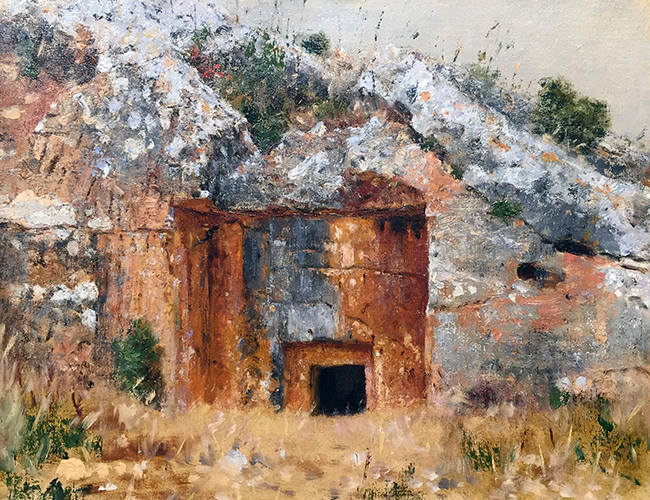VASILY VERESHCHAGIN PAINTINGS FOR SALE & BIOGRAPHY
VASILY VERESHCHAGIN
Russian, 1842–1904
BIOGRAPHY
From the age of 7 to 18 Vasily Vereshchagin attended naval cadet school but he eventually enrolled at the Academy of Fine Arts in St Petersburg where he worked under the direction of A. Markov and A. Beidemann, winning a medal in 1862 for his depiction of Ulysses Killing the Suitors. In 1863 he left for the Caucasus, where he lived in Tiflis (now Tsibili), giving drawing lessons and also producing a considerable number of sketches. The following year, with help from his family, he went to Paris to become the pupil of Jean-Léon Gérôme (1824–1904) at the École des Beaux-Arts. However, dissatisfied with the teaching methods in Paris, he soon returned to the Caucasus. In 1866 he exhibited a work entitled Dukhobors (Russian Dissidents) Chanting Psalms at the Salon de Paris, which drew attention and caused debate. Gérôme gave Vereshchagin an introduction to Alexandre Bida (1823–1895) and Vereshchagin provided St. Luke for Bida’s Illustrated Bible. Thanks to Bida, Vereshchagin collaborated in the World Tour and published an illustrated account of his Travels in the Caucasus.
From 1867 to 1869, Vasily Vereshchagin joined General Kaufmann’s campaign in Turkestan. This gave him both the taste for travel (he would later travel extensively in India and Tibet, the Near East, Central Asia, the Philippines, USA, Cuba, and Japan), and a burning desire to promote peace by depicting the horrific realities, rather than the glories, of war.
Around 1869, he painted the decorations for three rooms at the Ministry of the Dominions. The same year he made his way back to Turkestan. The year 1871 marked a change in Vereshchagin’s life. The deaths of his parents put him at the head of a fortune which guaranteed him total independence. He later settled near Munich. For two years, he withdrew from society altogether and spent 12 to 15 hours a day working on his paintings. Following a visit to India, he returned in 1876 to Paris where he had two enormous specially fitted studios built at Maison Laffitte which would allow in maximum light. He accompanied the Russian army in the Russo-Turkish war of 1877–1878 and the death of a brother, killed during that campaign, perhaps increased the ardor of the Apostle of Peace even further. He also journeyed to Turkestan and in 1884 to India followed by Syria and Palestine. While in Palestine he appears to have researched material for a series of compositions relating to the New Testament. He was back in Moscow in 1893, pursuing his anti-war self-styled apostolate through a series of paintings on Napoleon’s Russian campaign. They became the basis for illustrations in the Comte de Ségur’s book Napoleon.
In 1894, Vereshchagin travelled to Arkangel. In 1901 he was in China with the allied troops and by 1904 in Port Arthur, among the ranks of the Russian army. During this time he painted Admiral Alexeev Reviewing His Troops and his last work, Admiral Makarov Holding Council with His Officers. He perished, one might say pencil in hand, when the Petropavlovsk was torpedoed.
Vereshchagin organized many exhibitions of his work during his lifetime, including an exhibition of his entire oeuvre that was seen first in Paris and later in St Petersburg. After 1878, another exhibition of Vereshchagin’s works in London and various cities across England met with some success, although this was mitigated by some strong criticism.
Vereshchagin created special settings and special effects at the exhibition venues, which were given an oriental feel. The paintings were lit by electric light, while martial music and soldiers’ choruses resonated throughout the exhibition space. This created a considerable impact and even encouraged the German emperor to see the exhibition, a success confirmed in St Petersburg where the exhibition attracted more than 200,000 visitors in just two months. Vereshchagin enjoyed the backing of several powerful patrons, particularly the Prince of Wales, the future Edward VII, and in 1887 an exhibition in London of Vereshchagin’s views of British India. His compositions depicting scenes from the Russian campaign were exhibited in London in January 1899. With a view to having his peace mission officially recognized, in 1900 he exhibited a sizeable number of his works in Oslo and filed, unsuccessfully, his candidacy for the Nobel Peace Prize (Benezit, Dictionary of Artists, Gründ, 2006).
Museum Collections:
Brooklyn Museum, Brooklyn, NY
Museum of Fine Arts, Boston, MA
Rumiantsev Museum, Moscow
St. Louis Art Museum, MO
State Tretyakov Gallery, Moscow
Tver Art Gallery, Tver
Valtion Taidemuseo, Finnish National Gallery, Helsinki
Mark Murray Fine Paintings is a New York gallery specializing in buying and selling 19th century and early 20th century artwork.
Please contact us if you are interested in selling your Vasily Vereshchagin paintings or other artwork from the 19th century and early 20th century.
VASILY VERESHCHAGIN
Paintings for sale
Vasily Vereshchagin
Paintings Previously Sold
VASILY VERESHCHAGIN
The Adjutant
Oil on canvas
19¾ x 29¾ inches (50 x 75.5 cm)
SOLD
VASILY VERESHCHAGIN
The Taj Mahal, Evening
Oil on canvas
18¼ x 24 inches (46.5 x 61 cm)
SOLD
VASILY VERESHCHAGIN
One of the old Jewish Tombs near Jerusalem
Oil on canvas
10½ x 13½ inches
SOLD





